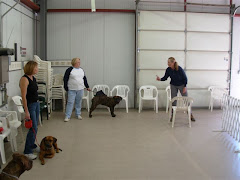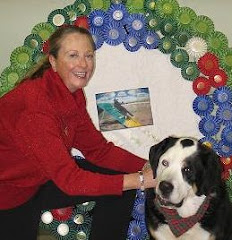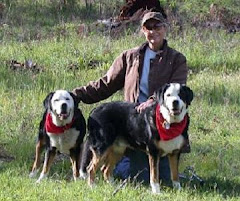Frequently when I tell students to "praise their dogs" for a good response to a command, they'll immediately bend down and put their hands on their dogs. While the dogs enjoy this petting and physical interaction, the owners' hands often get the dogs so excited that the dog ceases his "good behavior" (i.e., a good sit) before the owner has a chance to release him.
At this point, I have to explain my request:
"I said 'praise your dogs,' not 'pet your dogs.'"
To be perfectly clear, "praise" comes from your mouth and your face, not from your hands. It's perfectly acceptable to your dog if you merely look down at him, with a pleased expression on your face, and verbally praise him:
"Yes!"
"Good sit!"
"G-o-o-od!"
"What a dog!"
 |
Jennifer Norton in a Rally Obedience class with her dog several
years ago at Manning Dog Training in Yakima. Notice how she praises
her eager dog without petting him. |
In modern-day dog training terminology, this verbal praise is known as "marking" the behavior you like. He sits on command, and you "mark" the behavior with a signal that tells the dog he did the right thing. This is how clicker-training developed years ago...the audible "click" is quick, short, and concise, so the dog immediately understands the connection between his good behavior and the click, which is usually followed by a treat.
To better understand how verbal praise alone can be a more effective, clearer reinforcement of good behavior, think back to when you were in second grade, sitting behind a desk in a classroom. The teacher poses a question, and you're the first one to answer it correctly. Which of the following responses will keep your mind channeled on the subject and ready to answer the next question as quickly?
- Teacher remains at the front of the classroom and says, "Yes! Good job!"
- Teacher walks over to your desk, leans down, pats you repeatedly on the shoulders and says "What a nice girl you are!"
You probably picked #1. Your dog operates the same way. If you want to keep him "on task," forego the petting and stroking during the lesson, and teach him to accept verbal praise. It's quick, concise and less of a distraction. Your voice is far more effective than hands. Vocal praise allows you to remain upright in a leader-like posture, without muddying the waters by bending down and touching your dog. While touch is extremely important as an emotional regulator, it can be a bad distraction when you're trying to teach a specific behavior.
Teach the dog to eagerly seek your
verbal praise. There will be ample time at the end of each lesson to put your hands on him and give him an appreciative hug.





















No comments:
Post a Comment